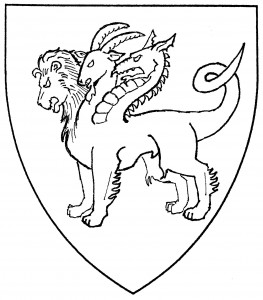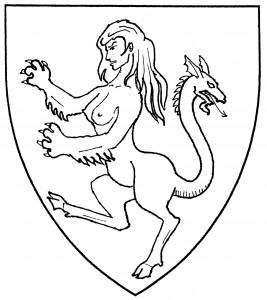The chimera, or chimaera, is a monster from Greek myth, combining parts of a lion, a goat, and a dragon. No two authors agree, however, in exactly which parts go where. The standard heraldic form, dating from 1572 [Bossewell II.66], comprises a lion’s body, a dragon’s tail, and the heads of a lion, a goat, and a dragon sprouting from the shoulders; this is the default Society chimera. The illustration shows this chimera statant. (Sometimes the dragon’s head was shown at the end of the tail, instead of the shoulders.)
A more classical form, depicted on ancient Greek urns, has a lion’s head and body, dragon’s tail, and a goat’s head grafted to the small of the back; this form is blazoned as a “Greek chimera” in Society armory.
Yet another form, more common in German heraldry, has a lion’s head, a goat’s body, and a dragon’s tail; this form may also be shown with the face and breast of a woman [Volborth 47]. This form is blazoned a “schimäre” or “German chimera” in Society armory. The illustration shows a schimäre rampant.
Maximilian Gartenheit of Heatherwyne bears: Per fess argent and gules, a chimera passant vert.
Lyonnete du Soleil bears as a badge: Azure, a Greek chimera statant to sinister Or within a bordure lozengy sable and argent.
Kevin Burnett bears: Sable, a schimäre rampant contourny argent, a base rayonny ermine.

